Football Manager 2024 Pep Guardiola’s Barcelona Tiki-Taka Extreme Possession Tactic 2-3-2-3 / 2-1-4-3
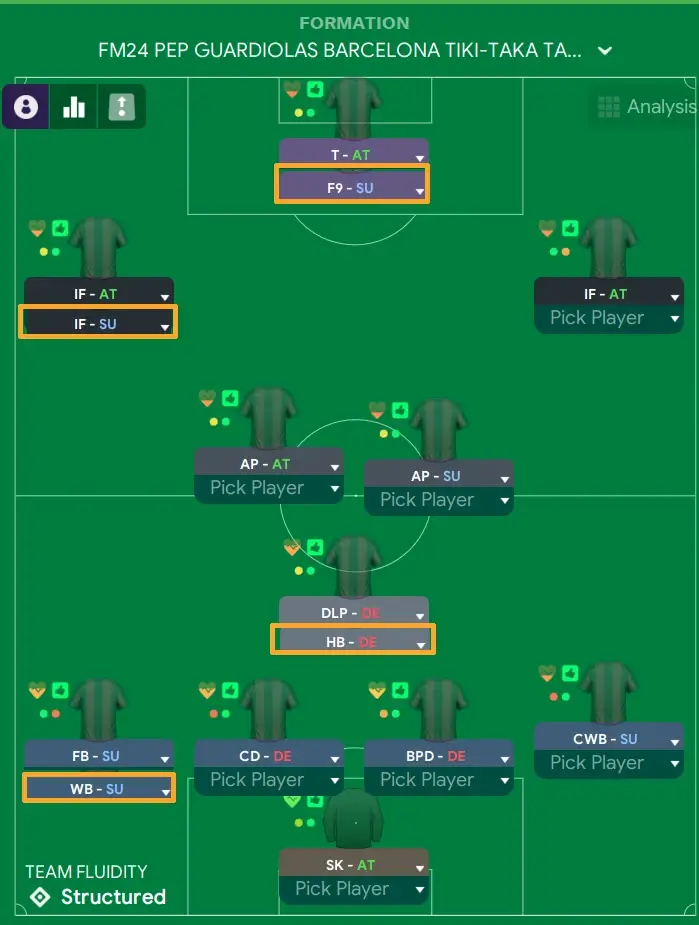
The Football Manager 2024 Pep Guardiola Barcelona Tiki-Taka 2-3-2-3 tactic by Passion4FM.com is set up in a traditional 4-3-3- formation with a midfield trio containing three playmaker roles – all capable of moving the ball decisively around the park and make those lovely through balls to set up the inside forwards.
The 4-3-3 formation maintains the 2-1-4-3 / 2-3-2-3 shape in possession and creates perfect triangles when building out from the back without leaving gaps between the central defenders and wingback for the opposition team to counter in. Something that was one of the weaknesses of this system defensively.
With the high defensive line and the higher mentality of the wingbacks, this tactic is highly risky at the back – meaning it’s fragile for counter-attacks, especially if the opposition team features quick strikers capable of carrying the ball forward.
Image of 2-3-2-3 formation for FM23 can be seen here.
Despite of the increased risk, the results in possession of the ball and the likeliness to dominate the match outweights the cons. As far as you got the right personel to adopt such a demanding playing style, both in and out of possession.
Download Football Manger 2024 Pep Guardiola’s
Barcelona Tiki-Taka Tactics by Passion4FM
Get Passion4FM’s Football Manager 2024 Barcelona Tiki-taka tactics, that are founded upon Pep Guardiola’s positional play. Control and dominate matches with free-flowing passing football, and experience beautiful movements, lots of passes and more distinct goalscoring chances than the opposition.
About The 2-3-2-3 Formation
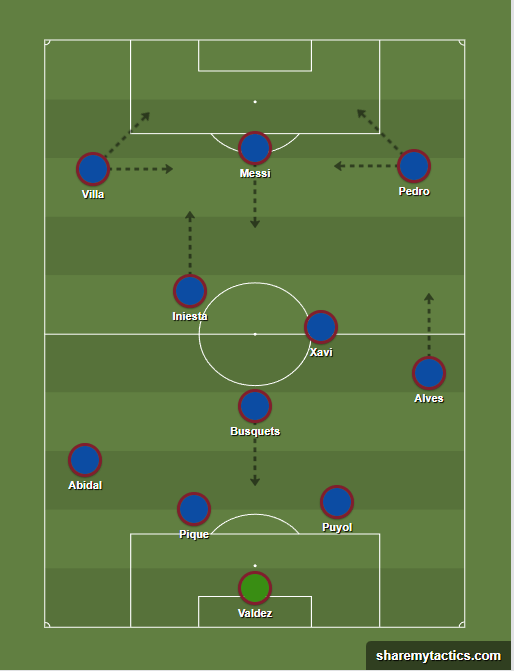
From what you have discovered or noticed from the tactical analysis I like to use a 2-3-2-3 formation as a foundation for the Barcelona tactics.
You can call the 2-3-2-3 formation my positional template*. The system makes it rather simple to record a 4-3-3 or a 4-1-4-1 in the defensive phase, a 2-1-4-3 or a 2-3-2-3 in the attacking transition phase and a 2-3-5 / 3-3-4 in the attacking third simply by the change of player roles and duties.
It’s a rather flexible system which gives a good foundation for ball circulation and high pressing play as it naturally creates lots of triangles.
The set formation dictates how the players will position themselves in the defensive phase of play meaning that the choice of formation will determine how you will defend with the help of player duties.
With the 2-3-2-3 tactic and the use of specific playmaking roles and duties I’m able to create a system that position players in many lines of play – making it harder for the opposing team to play their way through the centre of the pitch, and forces them to play more direct and on the counter which might be uncomfortable for them. By forcing the opposition to make rushed decisions and play more direct, the aim is to increase the teams’ likeliness to intercept passes and pick up loose balls.
The 2-3-2-3 formation is based on the same principles as Guardiola’s playing style: a compact unit which creates lots of triangles and rhombus’ which is favourable for ball circulation, but also for regaining possession quickly as everyone has a player in cover and are closely connected standing only a few meters between each other. The formation is highly balanced giving you the best foundation for extreme possession football in my point of view.
The basic 2-3-2-3 formation you can download below has become one of my favourite systems as the movements from the players (with correct player preferred moves) exploit spaces in a way that you can easily get into the final third by neatly threaded passes which looks to split the lines open.
While this tactic might seem more complex, it is based on providing a better balance between the player’s responsibility and movements within the framework of 2-3-2-3. It aims to overload a typical 4-4-2 formation or any systems using a maximum of 4 midfielders as the formation transits from a 4-1-4-1 in the defensive phase to a 2-1-4-3 or a 2-5-3 in transition, while it resembles more an asymmetric 3-3-4 formation or an ‘unbelievable’ 2-3-5 formation in the attacking phase when the opposition team is pinned back into their own penalty box.
If you’re using the false nine role he may often drop deep to get the ball in the attacking transition phase and the shape can resemble a 2-1-4-3 formation. If the defenders stay deep rather than track his movements and tries to close down the movement of the false nine, it will give him time to turn, get an overview of the passing alternatives and importantly makes him able to dribble with the ball at full speed against a retreating opposite block.
The 2-3-2-3 system aims to replicate how Guardiola wants to overload on one side in order to open up space on the other to create goalscoring opportunities from. As you will notice the triangles and rhombus shapes are more narrow on the right side than the left, which aims to create numerical superiority and better opportunities to circulate the ball; both quicker and with an intention – to penetrate from deep – getting the complete wingback free of marking on the right while the inside forward left will stretch play giving the team the chance to switch the ball over to the opposite flank.
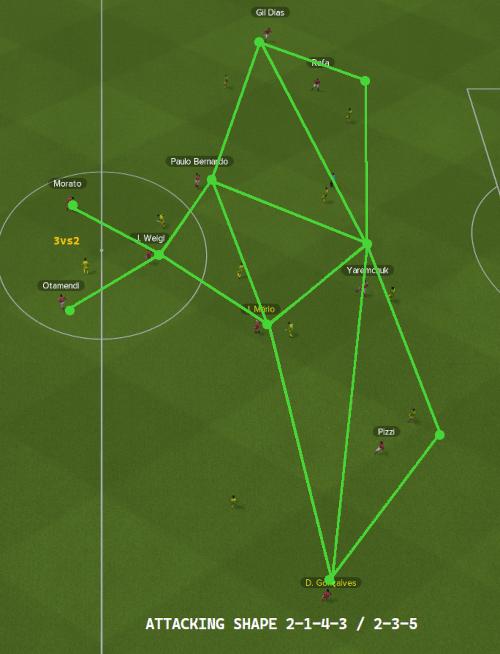
On the other hand, the formation is rather flexible, giving me a vast amount of opportunities to alter the match tactics according to the opposition team. I can quickly alter it to a 3-4-3 formation, 4-1-2-2-1, 2-3-5, 5-3-2, 2-5-3, 2-1-4-3 or a 3-1-3-3 formation depending on what is needed to create numerical superiority in the middle as well as down the flanks simply by a change of player role and/or duty.
By selecting wingbacks and inside forwards at support duty I would easily create a 2-3-5 formation in the attacking phase as they will overlap on the flanks simply because of the duty selection – taking up positioning in the midfield-strata – rather than selecting another team instructions (look for overlap, which makes the playmakers hold up the ball even more than they do – increasing the risk of losing the ball in the centre of the pitch).
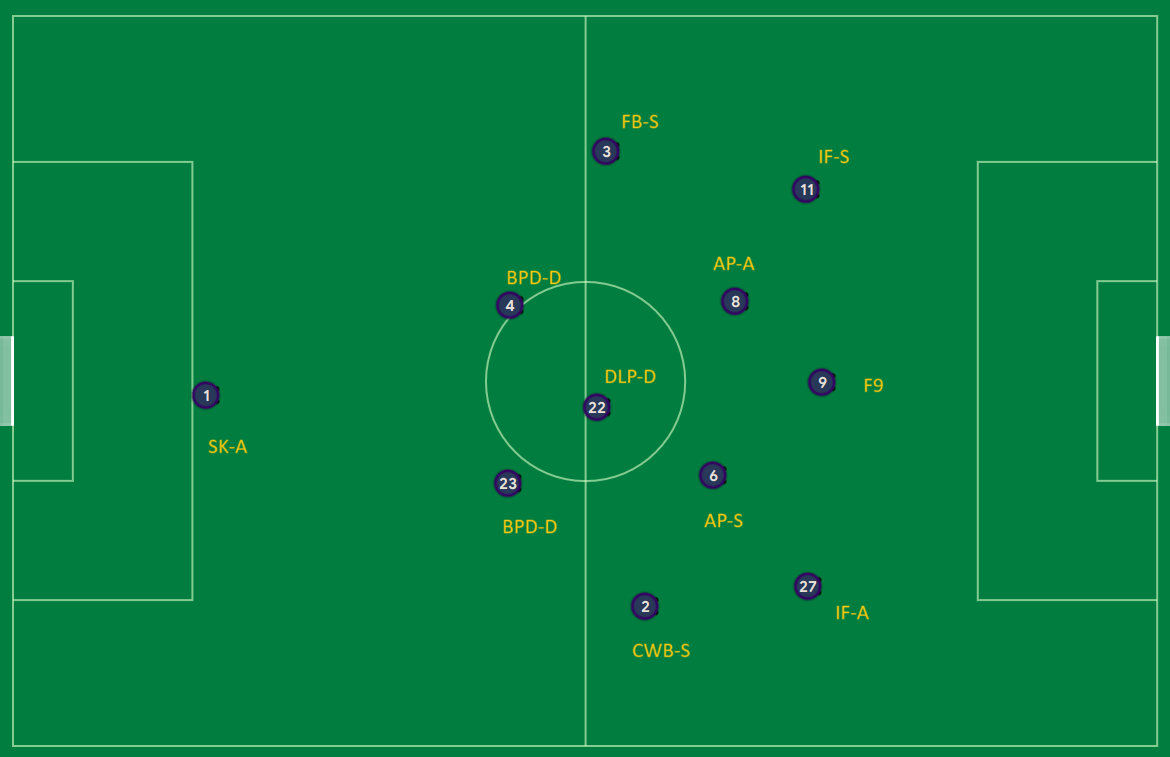
While this system creates the shapes and positional play I want in Football Manager, I’ve experienced that the opponent tends to park the bus against it using a Cautious or defensive mentality. What happens most often is that the opponent looks to play on the counter-attacking the spaces behind the defenders. With the opponent playing highly compact with a low block there might be times you find yourself struggling to score goals.
If you encounter lots of blocked shots remove ‘Work ball into box (if it’s ticked), select a bit wider attacking width and increase the tempo a bit. You can also change the fluidity by adding more attacking duties (e.g. the wingbacks and inside forwards).
Another choice is to change the deep-lying playmaker support to an Roaming playmaker/Advanced Playmaker (S) to increase the number of forwarding runs or runs penetrating the opposition lines, and the advanced playmaker attack to ‘Mezzala’ support/attack.
An asymmetric 2-3-2-3 system can be achieved by changing the right complete wingback from support to attack duty. This will replicate how Barcelona build-up play with more movements on the right side than the left. Most notably is the forward runs from the attacking complete wingback into the space providing passing alternatives for Xavi, Messi, and Iniesta to switch the ball to. This is allowed as the right ‘Inside Forward’ will sit narrower running diagonally into the centre as the ‘False Nine’ drops deep. The ‘Advanced playmaker’ will provide cover for the CWB forward runs as he will Hold Position. In these situations, you might want to change the AP-S to DLP-S as he will stay a bit lower and give room for the IF who moves inside when CWB-A runs forward. The AP will also look to make play unpredictable by swapping between retaining possession and play through balls from zone 14 – normally to the false nine or into space for the inside forward support to run onto.
While the play is concentrated on the right will the AP-A look to get into the box by deep runs (PPM: Gets into opposition area). He will provide a second option of penetration as his dribbling and forward runs will look to destabilize the opposite defensive block. While the CWB-attack can be considered a free man on the right side, I want the Mezzala to constantly get behind the pressuring lines as another free man. I consider the left inside forward (attack duty) as the ‘main’ goalscorer as the false nine will prioritize to play killer passes into the penalty box towards the left IF, who will exploit any spaces or gaps. But the deep positioning of the right inside forward who will stay closer to the false nine will be an ideal opportunity by them to play one-twos with each other.
Some would argue that the wingback in support duty will give the deep-lying playmaker and the defenders an additional passing option when building out from the back, I have simply wanted a lower mentality to provide cover for the attacking runs of the left IF and the advanced playmaker attack (left). The wingback support will not only look to counter the advanced position of the opposite winger (in attack duty) but it will stretch play vertically dragging the opposite player of the MCL to move out of position when the left wingback has the ball. It also gives more passing alternatives for the left inside forward by creating a better triangle.
The Inside forward support (right) have the option to cut inside to the edge of zone 14 and may play through balls to an on-rushing false nine if he should receive the ball. Acting like a fake attacking midfielder he will look to overload the half-space by first staying deep to get the ball in order to create space for the complete wingback who stretches the width on the right flank providing a dilemma for the DC and DR. What happen is that the AP-A makes the third line of pass (through ball) to the false nine, who uses the passing option to the wide channel (CWB-R), but here he had several options – like going for a one-two with the IF-A (right).
Note! The tactical system aims to leave the centre (the penalty box) open in order for the players to run into creating trouble since as many as 5-6 players are rushing at the opposite defensive line depending on the duty of the left fullback / wingback.
An Overview of The Tactical Systems: Barcelona 2008-09, Expansive Football & 3-4-3 Tactic
Alongside the default Pep Guardiola Barcelona Tiki-Taka Tactic for Football Manager 2024, the download pack contains four other variations which gives you more tools in your toolbox to get the winning edge.
Which systems you prefer to use will largely depend on what type of players you got at your disposal and how you wish to attack to break down the opposition team.
You can use these tactical variations if your chasing a lead and needs to make a change to create better goalscoring opportunities by playing more expansive football with a bit more vertical Tiki-Taka approach, or change of player positioning and movements that helps to overload a particular area of the pitch.
Sometimes a subtle change of player role can massively impact the player performance. Perhaps a certain player isn’t suited to play in a particular player role, or a change in player mentality (more attacking approach) is required to open up the defence to come to goalscoring opportunities. For instance, by making more penetrating runs down the left side of the pitch as you might lack few runs behind the opposition line with both a FB-S, AP-A and IF-A on that side.
Below is a quick insight to the other tactical variations used by Pep Guardiola at Barcelona available to download in the Barcelona Tiki-Taka tactic megapack by Passion4FM.com.
Personally, I tend to change the player role and duty within the basic 2-3-2-3 framework if I struggle to create decent chances. It could be changing the duty of the CWB from support to attack, changing the movement of the Xavi role from a deep-lying playmaker to an advanced playmaker, change the role and duty of the forward (False 9 to a Trequartista or Deep-Lying Forward – Attack, or change the duty of the inside forwards from support to attack to create more movements into space to be on the end of the though balls. Most of these changes has been included for the FM24 version.
Using an Advanced playmaker (AP-S) for the Xavi role could be favourable if you face a deep double pivot system such as a 4-2DM-3-1 or a 5-2-3 DM wide aka 3-4-3 with two deep defensive midfielders. In these instances, the player will be more inclined to play between the lines of the oppositions midfield and defensive lines rather than holding a position between the wingers and the midfielders.
For Football Manager 2024, I have opted for using the Advanced Playmaker role to replicate Xavi’s style of play in the first years when Pep Guardiola were manager.
Pep Guardiola’s Barcelona 2008-09 Tactic
Coming Soon…
Formation: 4-3-3
In Possession: 3-3-4 / 3-2-5
Out of Possession: 4-1-5-1
“Freedom, [in the] last third, run, you’re allowed to. You start in a high position, and wide, but after that, you can do whatever you want.
“Basically from training to the game, up until the last third, he [Guardiola] used to call it the ‘Three Ps’ – play, possession and position. And the most important one was position.”
Thierry Henry, Interview with Sky Sports
Barcelona’s Expansive Tactic

The Barcelona Tiki-Taka Expansive tactic for FM23 looks to give you a different attacking approach whilst conforming yourself to the rules of positional play by creating multiple triangles that improves the likeliness of good ball circulation.
The only minor difference is the focus on overloads and movements, and the slightly increased focus on making more through balls from deep. It’s likely you’ll see fewer total passes, more direct play and more players in and around the penalty box.
The difference in passing network tells the picture of how the tactic differs in style of play with more width given to the overall shape – this to increase the space between the lines for more forward movements from the central midfielders.
In fact, the Expansive tactic has more similarities to the modern version of the Tiki-Taka used by Pep Guardiola at Manchester City. Simply change the left wingback to an inverted wingback and the left IF-S to an inverted winger or a wide advanced playmaker and you’re playing somehow similar to Manchester City or Arsenal.
NB! Use Inside Forward Attack instead of IF-S if you want to sacrifice possession over scoring more goals!

It’s not uncommon to see a reduction of passes from +800 to under 700 with a MEZ-S / AP-S partnership compared to a DLP-S/AP-A combination.
Other Tactical Variants Barcelona used under Pep Guardiola
Barcelona’s 3-2-5 Tactic
This system is often used against superior opponents where you want to defend in a 4-5-1.
It aims to replicate Eric Abidal’s role and positioning, who made fewer forward runs than Alves and tucked in to become the third defender.
Barcelona’s 2-3-5 Tactic
This variant is favored against opposing teams who are compact in the centre of the pitch with limited space to attack through the middle.
Instead, the priority is to create more width by stretching the shape and ask the wingbacks to travel forward and make more overlaps, like how Sylvinho and Daniel Alves did.
Image of FM23 Formation
Barcelona’s 3-4-3 Tactic
Facing opposing teams with two forwards who work close to each other? The 3-4-3 system might be the option.
With the halfback dropping in between the two centre backs you can create a numerical superiority at the back. It can also be used against 4-2-3-1 systems.
Yet again, the defensive positioning of the half back will free up the wingbacks to move further forward and give a better defensive balance against counter-attacks.
Tiki Taka Team Instructions
While the 2-3-2-3 or Il Pozzo’s WW formation is the template for my tiki-taka tactics we can say a specific setup of Team Instructions are the basics of the playing style. Here I would simply go through the team instructions I prefer to start off with for the match in order to replicate the tiki-taka playing style. As you might understand, a change of team instructions must be done if the team are unable to score or create chances, or at worst retain possession and control the match.
Match Mentality
While I’ve in earlier versions have favored to start off any matches on a ‘Balanced’ match mentality to analyze the opponent and look at their approach for the first 15-20 minutes of the match before making changes, before changing to ‘Positive’ or ‘Cautious’ depending on the opponent I face, I have since FM20 decided to use Positive mentality with a slight change of team instructions.
While the Balanced match mentality is not locked in on the tactic, it creates a good base in terms of movements, passing and creative freedom with the current choice of player roles and duties, but my preference is the ‘Positive’ in terms of the width and creative freedom it provides.
NB! You will need to assess match mentality yourself according to your opponent and how you anticipate they will play and react upon it by making tactical tweaks according to the events.
Tactical Options: What to do against Better Opponents?
The weakness of the 2-3-2-3 system is the focus on attacking at all times. Against opposing teams better than yourself, who might play Tiki-Taka or Gegenpress, it might be worth changing the match mentality to ‘Balanced’ and change some of the player roles (e.g left fullback from FB-S / WB-S to IFB-D to better protect the defence against two men forwards. This will put more emphasis on reducing the risk-taking and keeping more men behind the ball.
In Possession

With the ball, I like my players to patiently build up the play with much shorter passes at players feet working the ball around until space opens up. With much shorter passing ticked, coupled with a slightly higher tempo, the players will look to move the ball in a pass and move style of play that Barcelona was so famous for.
Even though I have instructed my team to play with a more patient approach in previous versions of Football Manager, the match engine of FM24 requires a slightly higher tempo to avoid the opposition to quickly close down the ball carrier. Overall, it’s focused on not taking any necessary risk in your own half, but to break with some irregularity by playing through balls and passes into space to an on-running player when entering the final third.
NB! If you like to see more through balls and a more expansive football being played, increase the passing directness to Shorter Passes. This is a great way to create more chances against teams who park the bus and is hard to penetrate.
These instructions will often favour the other players to look for one of the playmakers to pass to – making it up to them to dictate the tempo even further and let them use their vision to create chances or simply advance play. The four playmakers (deep-lying playmaker defend and support, the advanced playmaker attack/Mezzala and the false nine/trequartista) will be more disciplined in their approach to passing – recording a higher passing accuracy (around 85% or above) with shorter passes being ticked whilst they may hold up the ball and reduce the amount of killer passes with retaining possession. Here we must remember that both the MCR, MCL, ST, AMR, AML and the WBR has ‘Take More Risks’ ticked (either by default or selected in PI). As I see it, an inaccurate pass between the midfielders would be devastating as there is only one line behind them – giving the opposition team perfect condition to counter you.
A slightly lower tempo is necessary to ensure that the wingbacks get time to move higher up the pitch – trying to replicate the 15 pass rule of Josep Guardiola when building out from the back.
A slightly lower tempo may entice the opponents to close down your players more frequently and initially drag opponents out of position which makes it more likely to move the ball into final third (behind the first line of pressure with more lateral passes).
To increase the touch to goal ratio and to adopt a more pass and move game you can tick Dribble Less. This will reduce the individual’s creative freedom as they are more likely to retain possession and play a short safe pass rather than dribble their way towards the box. I’ve decided to not use Dribble Less to let the False 9 (and the Messi role do what he’s best at – creating chances for himself by carrying the ball forward.
Tactical Options: Yet again, here you need to assess the match before playing shorter passes and reducing/increasing the tempo according to the match mentality and how the matches evolve. It can also be advantageous to tick Focus Play Through The Middle.
Another tactical option at hand is to increase the tempo to ‘Slightly higher’. This is often used when opponents park the bus or are difficult to break down. It reduces the touch-to-goal ratio, in addition, to let your team move the ball in a more decisive manner. By moving the ball quicker, the opponent will have a harder time keeping their shape and may eventually create gaps to penetrate via movements and/or passes.
The Build-Up
The foundation for the passing style starts with how the goalkeeper distributes the ball and how the team plays its way out of defence. By ticking the play out of defence instruction it ensures that the players will pass their way out of defensive third with short passes, literally setting the passing length to extremely short for the central defenders and asking the players to take up the positions as described in how to play out from the back. While it may be dangerous against a team that presses high I rely on the defensive player’s composure and technical abilities to move the ball patiently out from the back until the opponent’s defensive block is destabilized and unbalanced – forcing the opposite team to move from side to side until the passing play are too quick for their anticipation and agility. By playing out of defence it looks to lure the opponent out and create gaps and pockets of spaces between the lines to leverage from.
Tactical Options It may be favourable to un-tick ‘Distribute to centre backs‘ (see In Transition) when facing an opponent who utilizes a much higher line of engagement and an extremely high pressing intensity which closes down your defensive line in situations when you possess players with low composure, first touch and vision, and instead use ‘Distribute to Full-backs’.
Final Third
In the final third I would like to see lots of through balls and vertical passes, trying to get the ball behind the opposition’s defensive line and into the penalty box. If I could have dictated by player roles that they should make through balls sometimes in the middle third, I would love the ability to set through balls too often in the final third.
By working the ball into the box I want my team to wait for an opening or work hard to create gaps which they can exploit. The only disadvantage is that the longer the attack goes on, the easier it is for the opposite team to defend collectively – by closing all the gaps. Work ball into the box will also reduce the number of wide crosses and long shots coming from outside the penalty area and finally make the play more centralized in the attacking third. This can have a huge advantage if your players have far better agility, first touch, technique and vision – being far better in smaller areas than the opposing team and can move themselves and the ball quickly in congested areas.
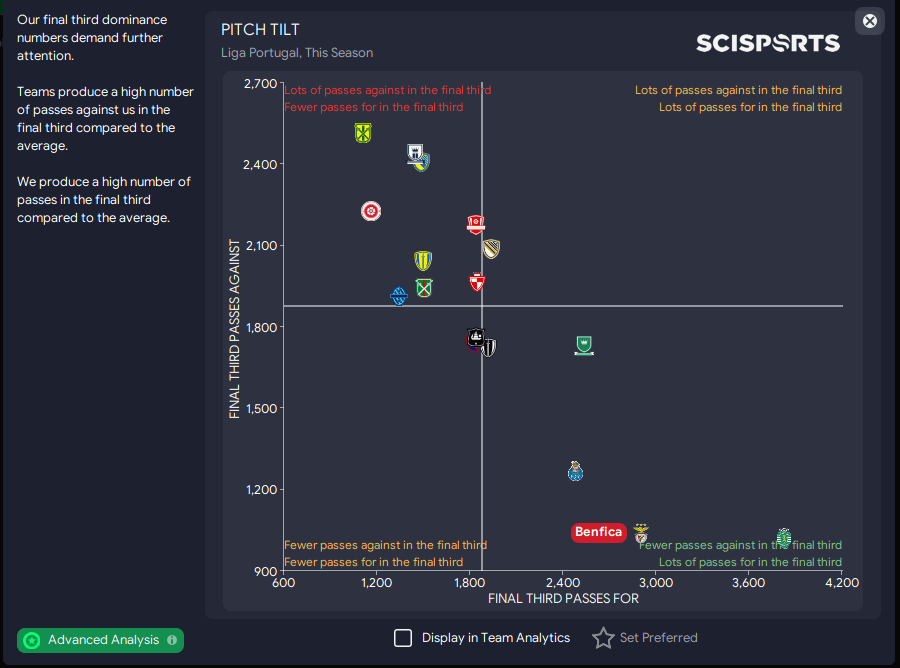
Tactical Options: I recommend to un-tick ‘work ball into the box’ if you are chasing for a goal against a strong defensive opponent and switch to a shoot on sight instructions, as you may be able to exploit rebounds coming from long shots – similar to what Pep Guardiola does at Bayern Munich, meaning that the players will be more likely to finish off the attack sooner rather than later.
Crossing
With the lack of height in the team I prefer to utilize low crosses which puts emphasis on players acceleration, positioning and off the ball movement, as the cross is played hard and accurate closer to the ground – around 15-50 centimetres above the ground.
A low cross like this is far more difficult to handle for the goalkeeper and the players marking the first post as the ball is played below knee height. Their cleverness within the penalty box will be an important factor – something players similar to Messi and Neymar should be the masters of. Since the defensive line is most prone to ‘forget’ the far post, I like to exploit this weakness by telling my wide players to deliver crosses to the far post, but these crosses can also be angled towards the outsides of the penalty area by specific player instructions.
Out of Possession
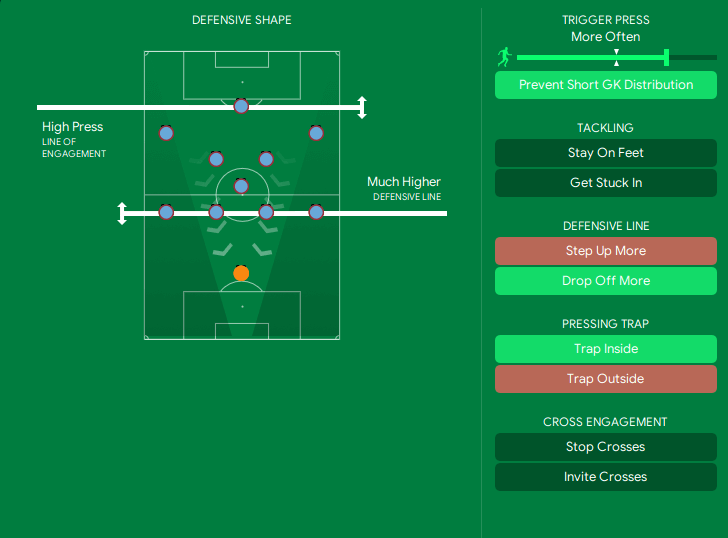
One of the ways Barcelona successfully regains possession quickly is with the help of their much higher defensive line which minimize the playing pitch. It ensures that the central defenders take up a position close to the centre circle providing both depths in ball circulation and squeezing the play into the opposite half. It gives the whole team the ability to start the collective pressing higher up the pitch compared to a deeper defensive line – literally minimizing the transition phase to some seconds, which aims to reduce each players workload.
Since the central defenders stay higher up the field it leaves a lot of space behind to be countered in, but it makes it harder for the opposition team to play their way out of defence as the first line of defence starts with the three forwards. These three forwards will be the first line of defence closing down all the time. This to regain possession as high up the pitch and as close to the penalty box as possible.
By using a higher defensive line and the positioning of the wing-backs in the 2-3-2-3 formation it ensures that the players stay closer to their markers, denying obvious passing options for the player with the ball. In order for the positional play to work properly, it’s important that the players mark zones rather than specific players. Players that are likely to roam around must not be followed, but instead, let another player in the system be in the range of closing him down if he receives the ball.
With the addition of instructing your players to use a much higher line of engagement, coupled with some specific opposition instructions you immediately limit the space and time on the ball for the opposing defensive line, trying to win back the ball as close to the opponent’s penalty box as possible. The much higher line of engagement coupled with a more urgent pressing intensity will make sure the team press collectively high up the pitch plus work their socks off to block off passing lanes and harass every player with the ball, forcing them to rely more on their football intelligence or technical abilities in one on one situations when being put under pressure. I like to force them to make mistakes by exploiting their weaknesses – either its a poor left foot, poor first touch or a low composure and vision and passing abilities.
More urgent pressing intensity will tell your team to close down more. This type of pressing intensity coupled with specific player instructions to close down more often (than by default for the player role) plus setting opposition instructions will ensure that the opponents will have less time to get control of the ball.
The end result of utilizing a high defensive line, team shape and positional system coupled with passing style lets you see a heat map like this:
The Use tighter marking ensures that the players will stay in a close range of his opposite marker, making it more likely to intercept passes. The single-holding midfielder combined with the two central defenders will record the most interceptions as they stay deeper to cover for the advanced players’ full pressing. Here you will notice the relationship between the high pressing, high defensive line and my aim to decrease the opponents passing accuracy when building out from the back – forcing them to utilize longer and more direct passes.
All in all, the high defensive line and pressing intensity ensures you dominate the game in the opposition half, meaning you will experience very few chances against.
In Transition
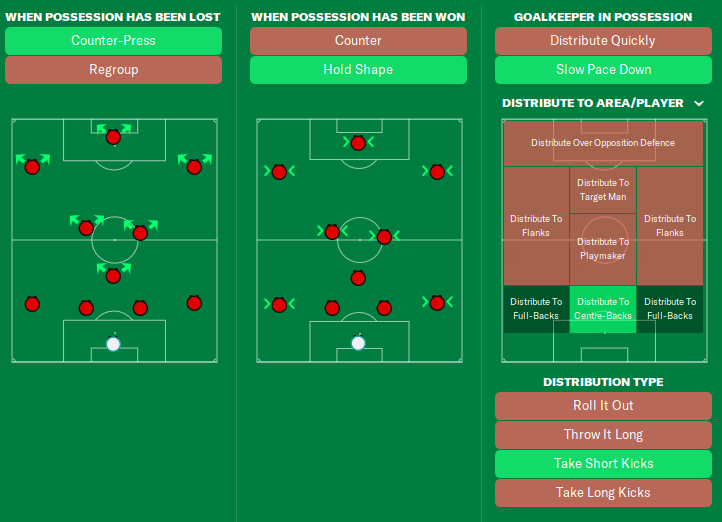
In the defensive transition phase, as soon as the team loses possession of the ball, I want the players to stand up and try to regain possession as quickly as possible by selecting the counter-press instruction. This means that the players will close down the player with the ball as high up the pitch as possible (in regard to the line of engagement setting).
When we get it, I favor the team to maintain their basic shape and start the attack all over instead of countering the counter. While it may be beautiful to watch and may provide you with some quick goals, the formation (in terms of player roles and duties) is set up to penetrate by destabilizing the defensive block by combination play and penetrating passes with the help of individuals excellent vision.
The Hold shape instruction ensures that the players can find back to their original position within the attacking formation making sure we don’t end up with one against 10 as one player runs with the ball deep into the opposition half without any support.
Tactical Variations
As explained in this detailed article, you have many options to turn the score into your favorite. And as mentioned, the success of the tactic relies on your players strengths – their capabilities to play in a role. When it comes to in-match changes there are many things you could to to micro-manage the team by making minor tactical adjustements. How you decide to chase a goal in the last 10 minutes of a match, or keep a clean sheet is all up to you and how you perceive the match. However, there are a few recommendations I have in terms of this tactic:
- Change the DM from DLP-D to HB when you are facing an opposition who uses two forwards and an attacking midfielder e.g 4-2-3-1 formations. The same applies if the opposition presses high and looks to prevent a short distribution from the goalkeeper. The Half back will drop deep between the two centre backs and will ensure numerical superiority when building out from the back. In fact, I could have for easiness have released the tactic with HB set as default but I don’t like his average positioning
- Tick Dribble Less to better retain possession to thereby control the match or dominate the opposition by making quick-short passes to eachother. Applying this team instruction in companion with work ball into the box and hold shape will often lead to a greater possession percentage and ball share. It’s not uncommon to see 65-73% possession. Unfortunately, in the current match engine and if you’re facing a team who park the bus, it will lead to few chances (aka obvious goalscoring opportunities) and thereafter fewer goals scored.
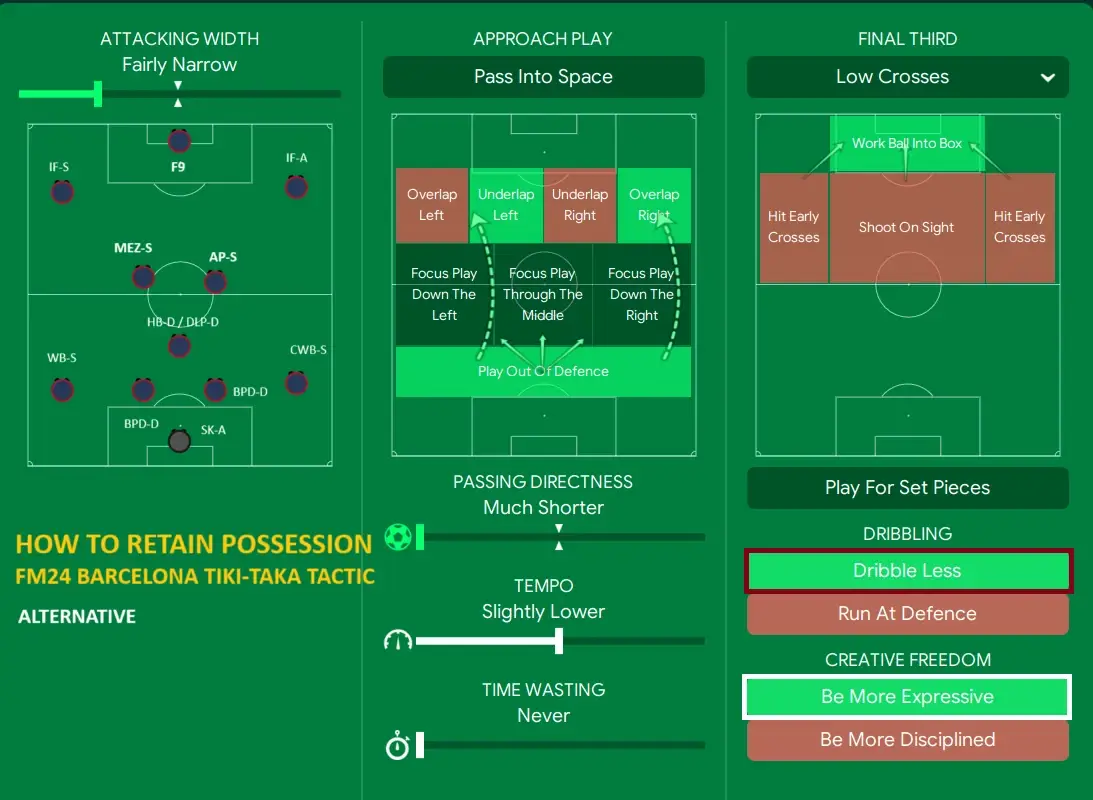
Fundamental Attributes
Applying such an extreme possession tactic requires time. Not only for the player to get familiar with their movements and instructions, but also about their relations with each other.
To make this tactic one step closer to success there are some specific player attributes you should target. Below I’ll list some of the main attributes that are important for this tactic.
- Teamwork
- Anticipation
- Vision
- Decisions
- Composure
- Passing / First Touch / Technique
- Off the ball (attacking unit)
- Positioning (defensive unit)
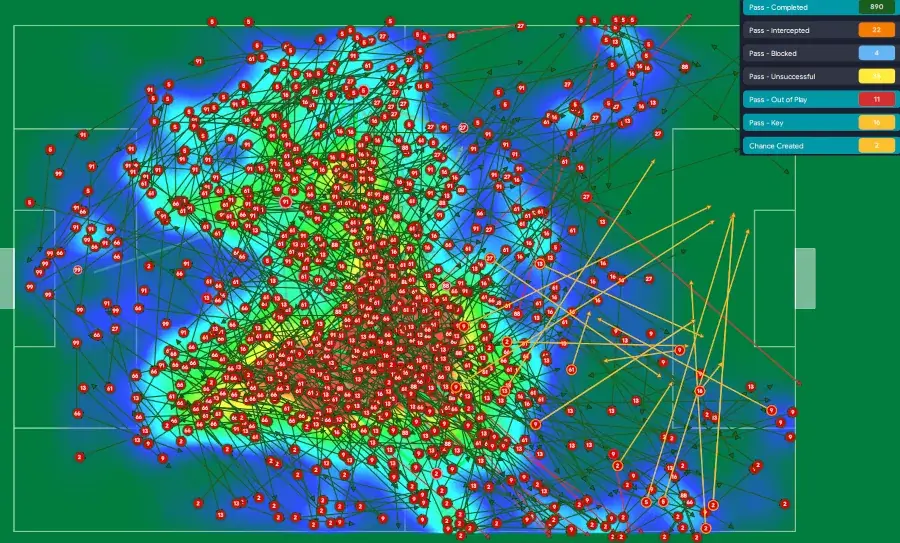
This will make the tactic retain possession more and work the ball forward in intricate passing patterns – back and forth until a gap to penetrate appear.
For further information about key attributes per position, see the illustration of the midfield diamond provided below.
Overview of Necessary Player Traits
How to Utilize the Width; Attacking Phase versus Defensive Phase
Utilizing the width will be one of the important aspects to succeed with a possession tactic in Football Manager. This is not only influenced by the pitch dimension but also in regard to the formation and its compactness.
The width will not only dictate how closely connected your players are but also how you can exploit gaps in the opponent’s tactical system by setting the correct width. Setting the width will not only be one of the most important tactical decision from match to match according to the opponent in order to exploit weaknesses and eliminate strength, but should be carefully considered in order to play according to your team’s strength, either you may have better players on the flanks than in the centre and according to your football philosophy.
In Football Manager 2024. the team’s defensive width is not set. It depends on the opposition’s player strengths, their shape and tactical instructions whether I use ‘Stop Crosses’ or ‘Invite Crosses’.
Attacking Width
In regard to the attacking width, this has been done with the knowledge that some of the foundations for ‘correct’ width is already implemented for you by player instructions, choice of starting mentality and player role behaviour. Do remember that the wingbacks will provide the main width of the system by staying wider.
The level of attacking width should also be considered according to how you approach the final third; whether you focus play through the middle or down the flanks.
What’s important to remember is that your objective is to be compact in the middle of the pitch, controlling the centre, whilst utilizing the full surface of the pitch. By stretching the play diagonally by increasing the width it aims to create more space between the fullbacks and centre backs of the opponent, giving more vertical space for the inside forwards and Messi-role to move into channels.
There are three options to go by relating to setting the attacking width.
- Set the attacking width to ‘Standard*’ or ‘Fairly Narrow’ without any focus of attack to ensure the playmakers are closely connected to each other and can play beautiful combination play.
* depends on whether you use Balanced or Positive Match Mentality. - Secondly, opting for ‘Fairly Wide’ width and ‘Focus Play through the centre’ to increase the effect of using Underlaps.
- Thirdly, set it to ‘Wide’ and select Underlap Left and Right (or just one of them while you focus play down the opposing flank).
* Which option you select depends on the oppositions shape, their defensive width and how you can create spaces to penetrate in according to your strength and their weaknesses.
For FM24, I’ve gone by ‘Fairly Narrow’ Width to try to focus play through the middle. You can use Fairly Wide width to play more attacking expansive football and to ensure there are enough space between the channels to make through balls from the half spaces, if you fancy. Just remember that the width you select will also have an impact on where the focus of play is prioritized. This may result in an higher focus of attack down one of the flanks compared to that 33% through all three channels as we aim for.
This setting is to ensure the team plays like Barcelona, focusing the play around penetrating passes from the central zone and either half space channels.
The role of the Inside Forwards
Influenced by Luis Enrique’s tactical system of 2014-2015 season I tend to ask both or one of the inside forwards to sit narrower, but this may depend on the choice of duty for the left wingback (support or attack) and how you want the combination play between the false nine and the inside forwards to be.
The main purpose of instructing my inside forwards to sit narrower is to exploit the decision-making dilemma for the opposite markers (DC, DRL) dragging them closer to the centre providing more space on the flanks for the attacking wingbacks to maneuver in – providing better circumstances for overlaps to occur – forcing the opposing team to also take into account the threats from wide.
Midfield Diamond & Creativity
In order to replicate Guardiola’s football philosophy, I want a strong presence of technically gifted players in the centre of the pitch who are capable of using their vision and passing capability to split the defensive block apart – aka the midfield diamond who I want to stay closer to each other. As mentioned earlier this can be influenced by attacking width, work ball into box and/or focus play through the middle.
The creativity and vision demanded to make this tactic work are of utmost importance! The above illustration features layers of information which shows not only the key attributes required for each line of play but also the positioning of the players related to each other.
In addition to showing how the 2-3-2-3 behaves in the attacking phase, the illustration examines the main creators and who are most likely to create chances, key passes and assists. With literally four playmakers within the midfield diamond the player’s vision, teamwork, passing and technique need to stand out in order to break down the opposition defensive block.
As you’ll notice, the F9 / DLF-S or Trequartista requires both the capability to finish off attacks while also setting up his teammates into goalscoring positions.
The positioning of the midfield diamond ensures superiority in the half-space channels with the Treq/F9 dropping deep and coming close to make space for the inside forwards or by creating triangles with his partnered playmakers. With his off the ball movements and the positioning of the midfield playmakers and inside forwards working the half-spaces it aims to get numerical superiority (3vs2) against the opposite DC/FB’s.
The blue and red triangle in the middle of the illustration aims to describe not only the level of creativity which increases as the closer you get to the final third but also the passing risk. One of the players with the most assists throughout the season is often the CWB (right) with the defensive playmaker and the advanced playmaker coming next.

For FM24, we have decided to reduce the number of passes to enable the team to create more chances and thereby score more goals.
It’s not uncommon to experience the advanced playmaker record over 100 key passes per season, with the defensive holding playmaker (DLP-D) coming just as close.
The four creators working the centre channel will have the best perspective of play and can quickly change the point of attack, play lateral passes to a breaking player or simply move the ball into the final third or into the penalty box from zone 14. The MCL and MCR will be positioned on the edge of the centre channel and the half-space both stretching play for the false nine to drop into, but also maintain the perspective of play despite being positioned wider of the centre channel.
An extremely narrow positioning here would mean that the passing options out wide would be reduced – increasing the risk for the pass to be intercepted as it would be easier to defend against.
The angle between the central midfielders and the inside forwards ensures not only that the opposite team has to combat the strong presence and overload of players in the centre, but also have to take into account the ideal angles of penetrating passes from deep. The few meters between the inside forwards and the advanced playmakers makes it easier to regain possession if the ball path is intercepted.
Another benefit of the attacking wingbacks which stays wider is the tendency for the opposite team to ‘forget’ about them. If the play becomes too congested in the middle, the playmakers can easily switch the ball to the other flank giving the wingbacks the chance to move the play higher up – running towards the byline or come clear on goal.
The mix of attacking width and midfield triangle will see your team become lethal from all areas of the pitch, something your opponents have to take into account when defending. The opposing manager then has some important decisions to make. He can congest the middle leaving space down the flanks in a bid to reduce the space down the middle, or instruct his wingers to be more defensive.
No matter his solution, you will benefit from the space your opponent is leaving either it’s down the flank or through the middle – all the time forcing them to not make any individual errors in regard to positioning and closing down.
How Did FC Barcelona Score their goals?
Whilst talking about the midfield diamond, creativity and numerical superiority in half-spaces we can not come away from the topic about how FC Barcelona scored most of their goals. By watching old highlights it’s evident they looked to take advantage of the half-spaces by threading needle eye passes into the channels of the opposite defensive players. FC Barcelona frequently tried to exploit spaces between the defenders either via third line passes (passes split through the middle of two players which is one of the most desirable passes in the rondo) or movements.
Since most of your players look to utilize the spaces between the lines FC Barcelona was able to keep the passing triangles and support play perfectly. The only way to combat it for the opposition is to stay particularly close to each other and not get out of position whilst the Blaugrana players combine quickly.
Their focus on making through balls from the half-spaces vertically between the DC and FB was one of the reasons why Thierry Henry, David Villa, Bojan and Pedro scored most of their goals. A through ball from deep, inside forward accelerating behind the defensive line before either chipping or placing the ball in the back of the net.
It looks quite simple and wonderful to watch but requires timing of the pass and movement that’s extraordinary. The vision of the playmaker and ability of both the F9 and IF to create the necessary space to play the ball. With modern football being more aware of these channels it has been harder to exploit this area.
In order to make this happen in Football Manager, it requires a combination of the correct attacking width, off the ball movement and acceleration of the inside forward and the vision of the playmaker. One option is to look at learning the trait ‘Moves Into channels’ for your IF’s or re-train strikers into inside forwards.
Defensive Width
While I want my team to play wider than my opponent in the attacking phase I want my team to make the pitch as small as possible when defending. As the inside forwards are already staying narrower, it will be the main responsibility of the wingbacks to decrease width seeming like the team is always in possession as the positional play is maintained by simply reducing the meters between each position.
While diagonal width is minimized in the defensive phase it’s important for the central defenders to push up when the team is pressing high – squeezing play in order to leave less space between lines for the opposition to exploit.
In the heat of the match, it will be important to analyze the width and where you can leave space in relation to where you will close gaps for the opposition team. While I like to play compact leaving ‘no obvious’ gaps I tend to prioritize to instruct my team to play narrower than the opponent – forcing the opponent to utilize the flanks, since the centre (in front of the goal) is congested.
To limit the threat in front of the goal you have the option to ask the defence to sit narrower, or ‘Invite Crosses‘ as it’s called in FM23 or FM24. By doing this you’ll reduce the horizontal space between the defenders making it more difficult to penetrate through the centre. Selecting this team instruction will force the opposition to use the flanks. You need to analyze how the opposition plays and what may be beneficial.
Against a team playing with a 5-3-2 with wingbacks you could tick Stop Crosses and Trap Outside to try to limit the number of goals from crosses. Crosses into the box and how the defenders and goalkeepers reacts to them is one of the flaws of FM24 24.2 ME.
*The out of possession instructions for cross engagement is not selected by default, as you will need to consider the opposition’s shape, their goal threat from crosses and whether they are more likely to rely on width or play through the middle.
There are three obvious reasons why this may be more beneficial:
- Firstly, you force the opposition to relying more on crosses. The probability of scoring goals from crosses are lower than through balls made via zone 14.
- Secondly, a narrower angle reduces the chance of a successful pass is made. The angle, tied in with fewer passing options, means it’s easier to defend against. With the right pressing regime, you can limit the opposing player’s options to basically one solid option – making play more predictable to defend against.
- With the correct body shape and positioning, it may be easier to defend against passes or crosses from the flanks. The defender can force the ball to the opposing player’s weaker foot, forcing him to make cutbacks to change the point of attack. With the help of his teammates, the opposing player must rely more on his individual skills to get behind and into favorable areas. Here comes the qualitative superiority in.
Recommended pitch size in my point of view for any possession tactics are:
Short – Tick Team Instruction: Play Fairly Wide + Exploit the middle
Standard – Tick Team Instruction Use Default (Positive)
Short and Wide – Tick Team Instruction: Play Fairly Narrow
The pitch dimension you opt for will depend on your player’s level of stamina, how technically gifted they are, and how well they utilize fewer spaces.
*Note that the settings of attacking width will depend on the opposite match tactic as well.
Records & Stats
The tactic will normally, when fully familiar record around +60% possession, around 600+ passes per game, up to 13 shots per match and at least 1 clear cut chances per match depending on whom you are up against. Below I’ll simply add a few screenshots which show the typical statistics. Match stats made available below will not give the precise picture of the tactic, but an overview of what you can expect*.
Specific Stats of the playing style
General Performance
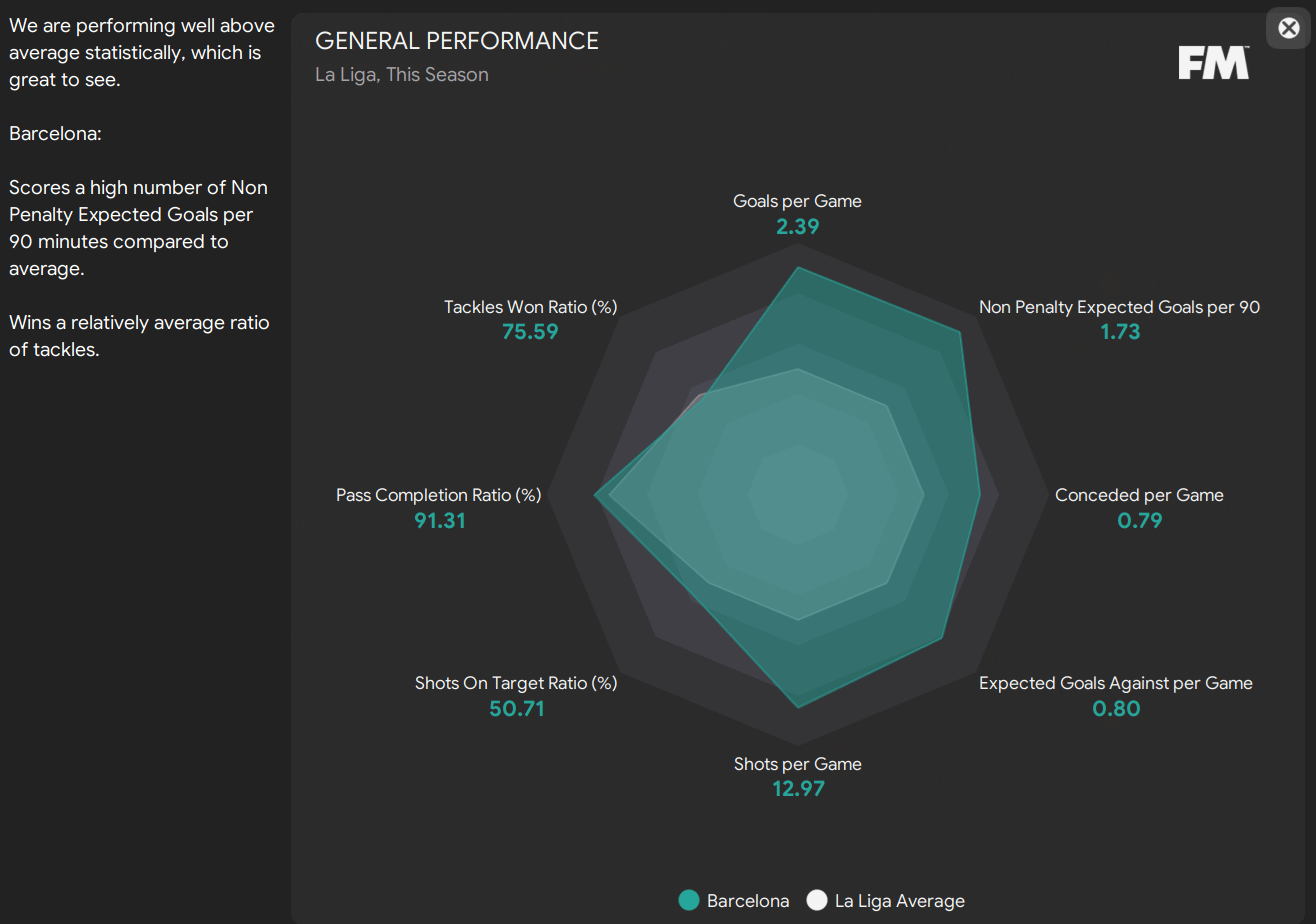
These records has been achieved with an attacking corner routine that scores lots of goals. Normally, you can expect around 1.8 to 2 goals per game without any specific set-piece routines applied.
Assists Types & Locations

The tactic is founded upon a pass your way to the goal ideology, where you’d like to see through balls and penetrating passes finds a player in open space, most preferable inside the penalty box, to place the ball in the back of the net. As the above screenshot reveals, most assists will come from the central area, where the vision of your playmakers and inside forwards will be important.
Goal Locations
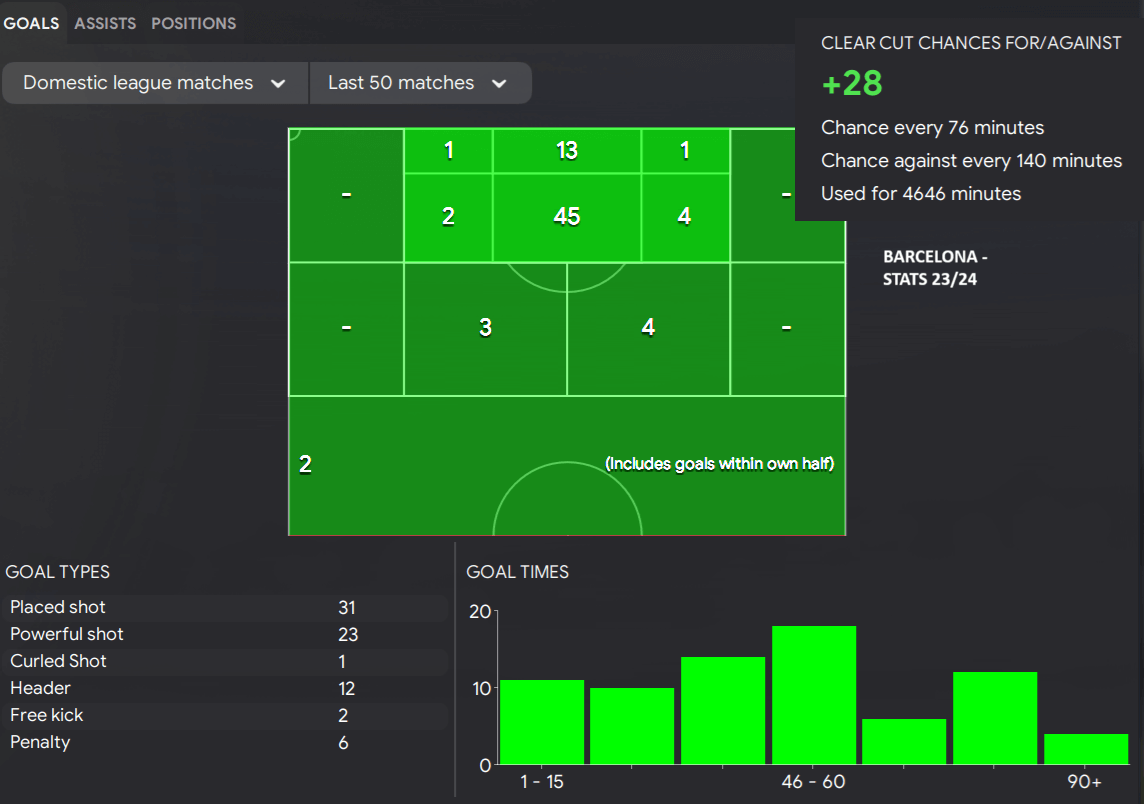
As this screenshot reveals, most goals come from passes made through (breaking) players inside the box, which is what I like to achieve by applying the ‘Work ball into box’ instruction. Goals are made after combination play often moving the ball wide before moving it inside. The inside forwards moves closer and closer to each other as play enters the penalty box and are often the ones finishing off the attacks as the opposite centre backs are busy marking the false 9.
With 45 goals scored inside the penalty at the full season, it shows the potential of this tactic as better forwards will be able to convert the chances more often. Remember this is with Robert Lewandowski as Trequartista, Ferran Torres and Raphinha.
Shot Accuracy

Defensive Efficiency – Shots Faced per game vs Opposition conversion rate


Tested with:
- Benfica
- Southampton
- Barcelona (several times with several different variations)
Notable stats:
- OPPDA: ~4.8 to 5.1 passes allowed per defensive actions
- Average possession: 60-65% depending on ME version
- Passes Completed: +21000 (~600-650 passes per game)
Passes complated against: lowest in the league - Pass Completion: ~91%
- Expected goals for: +/- 68 to 72 or around 1.8 to 2.0
- Conceded per game: ~0.8 per game
- Clean sheets: Amongst the top 5
- Chances Created: top 2 in the league
- Shots (on target) for: top 2 in the league
Shots (on target) against: Lowest in the league - Final Third Passes For: Highest in the league
Final Third Passes Against: Lowest in the league
Opposition Instructions
Opposition instructions are a great way to deal with specific players, their abilities and traits. It can be used to combat their main strength or force them to rely on their weaknesses. It can be used to limit a players time on the ball, the space around him or make him move into a specific area of the pitch, or finally, force passes to be made to specific players. It can help you target the best player of the opposite team by going in hard on him or force the opponent to rely on the creativity of a player that isn’t as good as their main playmaker who you man-mark closely.
The setup of opposition instruction is all about limiting the space and time for the opposite player with the ball. It looks to put the most pressure on the opposing defensive line, in order to win back the ball as quickly as possible as high up the field as possible. Even though I limited the use of opposition instructions from FM15 to Football Manager 2024, I have a template for combating specific positions that you might like to use.
No matter if you decide to set up specific opposition instructions for specific players or use this template for opposition instructions per position, there are some valuable things to notice, especially in regard to the show onto foot instructions.
- I look to force the player with the ball within the opponent’s defensive third to pass the ball inwards, providing a circumstance where central midfielders, wingbacks or inside forwards can intercept the ball patch.
- In the opponent’s attacking third I look to force the wide players with the ball to move outwards. This means that he will most likely run down the flank and be more disconnected with the rest of the team than if he moved inwards. By letting him move down the flank, you entice the player to cross the ball and recover possession inside own penalty box. It also gives your own players the time to get back into a defensive block and can be the difference between conceding a goal on the counter and regain possession in your own half.
- The above statement relies on the player role of the opposite wide player to be an inside forward who naturally wants to cut inside, and the wide player has not the crossing abilities and preferred foot to do it well. At these scenarios will the striker most often be better on the ground than in the air. If the wide players are more like a traditional winger and the striker is more like a target man, featuring strength, high level of jumping reach, high level of heading and are higher than your central defenders I look to force the wide players inwards. As you may have noticed, I try to force the player to act opposite of his natural behavior for the role he’s playing in.
At all other circumstances, I want players to be pushed inside into my pressing trap by showing players on to the opposite foot of their playing area (for example onto left foot for the right fullback or right foot for the central midfielder left. You will notice that I have not set up anything for the AMR / AML position. Here I use specific instructions for the player depending on if he is likely to cut inside or cross from the byline. It partly depends on the inside forwards dribbling abilities in relationship to acceleration and balance. Poor balance makes me favor hard tackling but closing down will depend on his dribbling capabilities. High dribbling and acceleration might force you to set closing down to never.
Note that I put as much pressure on the second and third line of defense and as much pressure on isolated player positions such as GK, sweeper, single holding midfielder, and central defenders/midfielders.

As years have gone by, I have refrained from using close down on every player, as player instructions and team instructions will help me a long step on the way to regain possession in the areas I favor. The circumstances where it may be favorable to set specific closing down for a certain player is in scenarios where the player records lots of assists, a possession completion ratio of around or over 90% and looks set to be the main playmaker.
In these circumstances I prefer to tight mark their main creative player – their playmaker – and tackle him harder to limit his time on the ball.
PS! You should ask to tight mark one of the defenders and trigger press on all the rest in the back line to try to win possession higher up and force the opposition to make more risky passes.
NB! Opposition instructions depend on the players I’m facing so take this image with a great pinch of salt! It’s only an illustration of how things can be set up – especially in regard to the pressing intensity of opponent’s defensive line.
What to do if?
Download Pep Guardiola’s
Barcelona Tiki-Taka Tactics for FM24
Get Passion4FM’s Football Manager 2024 Barcelona Tiki-Taka tactics, that are founded upon Pep Guardiola’s positional play. Control and dominate matches with free-flowing passing football, beautiful movements and create more distinct goalscoring opportunities than the opposition.
Published: 24.01.2024
Version: 1.0
Older Versions
FM19 2-3-2-3 Tactic – Download
FM20 2-3-2-3 Tactic – Download
FM21 Tiki-Taka Tactic 2-3-2-3 v3 – Download
FM22 Tiki-Taka Tactic – Download
FM23 Tiki-Taka Tactic – Download
Download Instructions
- Click the Download Link Above
- Extract the files by using WinZip or WinRar
- Move the file to
Your Documents > Sports Interactive > Football Manager 2024 > tactics - Open Football Manager 2024
- Click the + sign
- Or if you are starting a new save: Load Tactic beneath the list of tactical styles
- Load the ‘FM24 Pep Guardiola Barcelona 2-3-2-3’ or any of the other variants of Peps Tiki-Taka Tactics.
- Make sure the Import folder is Local
- Click Load
- Enjoy the Passion4FM FM24 Barcelona Tiki Taka Tactics!
Sources and Credit
Thanks to everyone who have tested my tactics before the official release, come to me with questions about how I approach things, clarified and improved my tactics using their knowledge by giving me inputs and recommendations on how to make something specific work in Football Manager.
Thanks to @Renys89, MikaelinhoFM and FranklyFM84 who have tested the tactic, or provided feedback and suggestions when I’ve been stuck, and who I have been able to discuss my thoughts around the tactic and what I’d like to achieve with it.
Thanks also to Josep Guardiola who makes the game more beautiful every day pushing the borders of what we today think is impossible and devoting his time to make football even more interesting to watch. If football was science, you are the Albert Einstein of football – coming up with concepts and innovating the game to a level we won’t fully comprehend until years have gone by and you have conquered everything possible in football.
Sources:
[#1] Juego de Posicion – a short explanation by author Rene Maric at Spielverlagerung.com. Last accessed 01.03.2016
[#2] Juego de Posicion under Pep Guardiola by Adin Osmanbasic at Spielverlagerung.com. Last accessed 02.03.2016
No copyright infringement is intended upon writing this article.


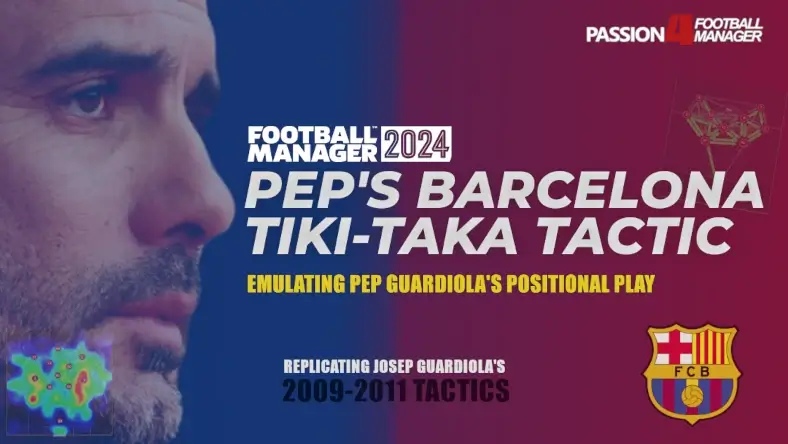






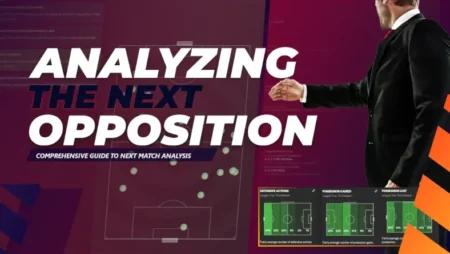
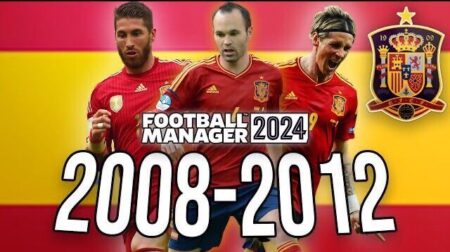
19 Comments
On Fm24 compared to last yr the Left IF-A effectiveness has dropped a lot compared to the right is there a reason why?
Good afternoon, I have a question, what can I do to keep the ball longer without moving it too much, just dribble less, or also put the be more expressive button on so as not to affect creativity?
Firstly, I would reduce the passing tempo if you feel it's too much direct. Dribble Less will also reduce the directness and players will instead retain possession more than before. Click be more expressive will increase creativity.
as I play with your tactic, and in the old opus you put dribbling less I had this question. but advise you to let dribble less untick at the beginning, and see during the match?
Sorry for all the doubts, but here in the tactic by default I have the underlaps selected but in the image here in the tactic they are not selected. 'it's normal?
Ciao! La tattica funziona veramente bene, Hai per caso un programma di allenamento aggiornato per Fm24?
Grazie e complimenti!!
I'm currently working on a training schedule megapack… testing and testing to see if I can get great development… Hope to release it this week if everything goes okey.
Ok grazie, ho letto anche che nella sezione che riguarda la tattica del 2008-09 del barça, c è scritto prossimamente, rilascerai a breve questa nuova tattica? Anche perché, L immagine che è sotto la descrizione non combacia con le tattiche trovate nel pacchetto che ho scaricato
Ancora una volta Grazie per il lavoro e per la pazienza che hai nel rispondere!
The 2008-09 tactic is in the package. I haven't taken the time to update that section or make a section for each tactic as I feel I need to focus on new content. That's the problem of maintaining the website alone.. I haven't time to update everything as well as publishing weekly, bi-daily content.
Sometimes, especially after new database releases I spend more time updating content than creating new stuff… Same goes for tactics and other testing once new ME version is out..So I can only apologize for not updating everything by point
What are the best teams to play tiki taka other than Barcelona?
Good morning,
When can we have the new schedules for fm24?
Trying my best to release them this week but I spent the last week testing them only to discover that I had made an error in the testing and the output was FAR better than the result as I had a mathimatical error in the Excel sheet. That resulted in trying to improve some schedules that actually worked very well and making them worse… Had to go back to try to find the good ones. But when every test I did went worse and worse, I got very frustrated. Hopefully able to release them within 1-3 days.
Hi Espen!! Looove your work!! Are you thinking about doing a recreation of Pep's Barca this year for FM 24 with the new roles that you can try to emulate movement of players such as Abidal and others? I would love to see your view on how to do it on this years edition of FM!
Great thread, I noticed the download pack doesnt have all the tactics noted/the tactics appear to be different than the ones explained, any advice?
Just a bit of laziness of me to update Everything for the latest version. It's easy to change the player roles and duty to what I show in the screenshots.
hi, congratulations for the great job!
I wanted to know when the tactical update will come out as I have encountered some problems after updating the game. Also I saw that there are new training plans, how can I use them better?
Thanks for the attention!
What tactic should to set for u-18 u-19
You would like to play with the 2-3-2-3 tactic. That's the one I have tested with the most. Depending on the type of striker you got, you can change to DLF if Treq doesn't suit you…but if you got an AF he will perform rather decent as Treq… I have managed Double with both Barcelona and Benfica – CL win with Barca and Lewandowski scored almost 0.9 goals per game
pic of opposition instructions missing